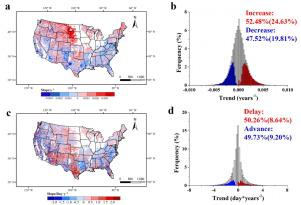Global and Planetary Change ( IF 3.9 ) Pub Date : 2021-09-29 , DOI: 10.1016/j.gloplacha.2021.103657 Ying Liu 1, 2 , Chaoyang Wu 1, 2 , Xiaoyue Wang 1, 2 , Rachhpal S. Jassal 3 , Alemu Gonsamo 4

|
Vegetation phenology and peak growth are important indicators reflecting the response of ecosystems to global changes, yet the trends in peak vegetation growth and its drivers have not been well analyzed across different ecosystems. Here, we used time series of satellite-derived Normalized Difference Vegetation Index (NDVI) (1985–2015) to track recent changes in maximum vegetation growth (the maximum of NDVI (NDVImax) and the peak of growing season (POS)) in the continental US, and explored their responses to both climatic drivers (i.e. temperature, precipitation and cloud cover) and atmospheric changes (i.e. nitrogen (N) deposition and atmospheric CO2 concentration [CO2]). We found that precipitation had the greatest impact on NDVImax, accounting for 31.7% of vegetated area, followed by cloud cover (17.1%), temperature (16.4%), [CO2] (13.7%), and N deposition (10.4%), respectively. However, temperature showed the largest contribution to POS change in about 41.9% of vegetated areas, followed by precipitation (18.6%), cloud cover (15.0%), N deposition (6.7%) and [CO2] (5.9%), respectively. Interestingly, the effects of cloud cover highly depended on moisture regime, that is, more cloud cover was associated with a delayed POS and a decreased NDVImax in wetter regions, but could advance POS and increase NDVImax in dry areas. In addition, we also found that an earlier POS was accompanied by a higher NDVImax in most ecosystems, but with lower NDVImax in arid ecosystems. These results reveal the control of both climatic and atmospheric drivers on peak growth, and consequently are of great significance for understanding of the responses and feedbacks of vegetation to global change and improve models of terrestrial ecosystem carbon cycle.
中文翻译:

全球变化对美国大陆陆地生态系统植被生长高峰及其时间的影响
植被物候和峰值生长是反映生态系统对全球变化响应的重要指标,但尚未在不同生态系统中很好地分析植被生长峰值的趋势及其驱动因素。在这里,我们使用卫星衍生的归一化植被指数 (NDVI) (1985-2015) 的时间序列来跟踪最近的最大植被生长变化(NDVI最大值(NDVI max ) 和生长季节高峰 (POS))。美国大陆,并探讨了它们对气候驱动因素(即温度、降水和云量)和大气变化(即氮 (N) 沉积和大气 CO 2浓度 [CO 2 ])的响应。我们发现降水对 NDVI max 的影响最大, 占植被面积的 31.7%,其次是云量 (17.1%)、温度 (16.4%)、[CO 2 ] (13.7%) 和 N 沉积 (10.4%)。然而,在约 41.9% 的植被区,温度对 POS 变化的贡献最大,其次是降水(18.6%)、云量(15.0%)、N 沉积(6.7%)和 [CO 2 ](5.9%) . 有趣的是,云量的影响高度依赖于水分状况,也就是说,更多的云量与湿润地区的POS 延迟和 NDVI最大值降低有关,但可以提前 POS 并增加干燥地区的NDVI最大值。此外,我们还发现较早的 POS 伴随着较高的 NDVI max在大多数生态系统中,但在干旱生态系统中NDVI最大值较低。这些结果揭示了气候和大气驱动因素对峰值增长的控制,因此对于理解植被对全球变化的响应和反馈以及改进陆地生态系统碳循环模型具有重要意义。



























 京公网安备 11010802027423号
京公网安备 11010802027423号